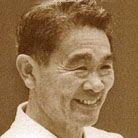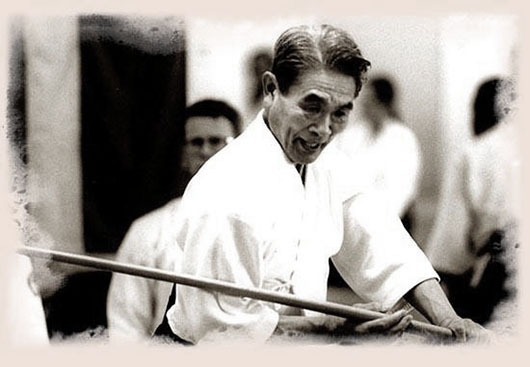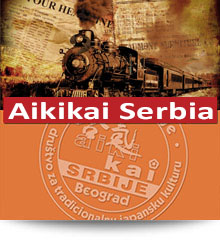aikido is a Language

Shoji Nishio Sensei (1927-2005)
8th Dan Shihan
aikido is a Language
This article by Nishio Sensei was first published in
Takemusu Aiki – Kanagawa Univsersity aikido Club – No. 6 1980
In martial arts the technique is an expression of the way of the art. Every martial art is involved in refining its technique. In aikido we too strain day and night to improve our technique.
Thus, let’s try to think about how we practise techniques and the contents of our techniques. The doubt that comes into mind is “Is it really ok that every time we practise we do it in the same way as it was done in the past?” I personally believe that it must not be the same. This is because I see the raison d’être of aikido as completely opposite to that of Japanese martial arts of the past.
There is probably no need to explain that the manner in which we practise, that is the way we seek the path, is expressed in our technique.
Since it is like that, then when we compare aikido with the martial arts of the past the way of expressing our technique must necessarily change (I use the word “change” but that is in the meaning “develop”).
Put specifically, it is a complete change from a budo that takes to a budo that gives, from the foolishness of collision to the richness of communion.
Therefore lets try to look at the techniques in aikido today. It is said that the techniques that are usually being applied in training are well above a thousand. The problem here is whether the aikidoka is diligent in refining and understanding correctly the meaning of those techniques.
No matter how many techniques you learn they will not be useful at all if you don’t understand the correct meaning of them.
In what way do we for example grasp and understand the concept of maai (Editors Note: Maai is the distance between attacker and defender).
As far as I can see it, the situation today is that most people just come to the dojo and move around without even having the honest doubts of a beginner (I can’t call that training).
I don’t think that budo training is good if we just copy the old stuff because that was the way it was done in the past. However I don’t mean to say that old things are not important. Of course they are important, but a critical mind like ”For what reason do we have to learn the old things?” should be the point of origin for real training.
It is my opinion that to know how to do new things properly it is necessary to know the old things and in that sense old things (in aikido’s case old techniques) are also necessary.
What I want to emphasize is that if we in our budo training always seek only old things then our budo will end up no good. A budo that follows the path of Kobudo (old martial arts) cannot survive the times and will end up as an empty shell.
Techniques in budo not only become useless when they get old, in time they may also do others harm and cause the ruin of ones own body. In that sense techniques in budo must continue to be renewed and improved over and over again.

Next, let us look at aikido that has a different training method from other budo. It is said that there are more than 1000 techniques in aikido and I will affirm that in one stroke. They all come from the one step of irimi. Irimi lets innumerable techniques emerge depending on its appliance in each situation and it is also here that we find the meaning of Takemusu aikido -a budo that creates.
From ancient times competitions have been used to determine the mental and technical level of a martial artist and also today this method is applied in different martial arts and sports.
It is only in aikido that this is not found necessary. Why is that?
To this question I was never able to get a satisfying reply from my seniors.
As commonly known it was very difficult to understand even half of the words that were said by the founder O-Sensei. If you understood one third you were among the top said the older students. Many years passed before I was in a state where I finally understood what I was told at that time.
It is now a little more than 10 years ago O-Sensei passed away and I have used the words of O-Sensei as a guidepost to reach the understanding of aikido I have today.
First, why is it not necessary with competition in aikido? This is because aikido was born with a completely different purpose than that of the old martial arts. The purpose of the old martial arts was to take – suppress, destroy and ultimately take the life of the opponent. Aikido was born to be a budo that gives - a budo that shows the opponent how he/she should live and prosper.
At this point it is necessary to compare with other Martial Arts. Each martial art continues in strenuous devotion to a specific kind of technique. For example some specialise in the sword, some in kicks and punches, and others in throws and holds. In other words each of them only knows one expression of budo and to test their progress they apply competition.
But in real martial arts a fight is nothing like that. It is to stand face to face with death, and not something like a contest.
Therefore the competition that many martial arts except aikido apply does not have a very high significance in a martial arts perspective and the same judgement has to be made on the practise methods that are applied in these arts.
It is not my intention to say that we should not compete but instead fight to the death. Such kind of thing cannot be allowed in modern society.
Therefore those people who want to know the strictness of real martial arts should already pause at this point and take a new look at things (in martial arts when confronting the opponent) and be strict against oneself.

”Being strict against oneself” in martial arts is to be able to, at any time, defeat and destroy the opponent that confronts you and not doing it. It is to make sure not to destroy the opponent but to greatly spare the opponents life.
Moreover, in order to foster the ability to make this possible, you must continuously practise with such mind and without lack of strict devotion through a long period of time.
In aikido the technique is a manifestation of ki and you can say it is a tool for reflection. KI is the source of life and that means the source of creation of all living beings. We cannot allow techniques that are generated from ki, from the source of life, to hurt other people.
In aikido it is possible with the principle of irimi issoku to instantly destroy the opponent. But people who know the foolishness of destruction and the preciousness of life should not destroy an opponent.
The techniques of aikido are such that the confronting opponent is given a place, a chance, for soul searching.
There are one, two or three places in each technique where you can destroy the opponent. These are the moments for soul searching.
In the process of performing a single aikido technique, no matter how simple a technique, the essence of each and every martial art is found. This is something unique to aikido.
Properly speaking this contradicts the fact that most people continue as ever to hit, clash and fight each other at the very moment of contact where you in fact with your aikido technique can control the opponent.
We start our practise by taking hold of the hand. In a modern martial arts sense, in the modern fighting sports and the like grasping the hand is unthinkable.
How do people who diligently practise understand this point? Most likely they just practise without understanding it all. Or rather maybe because they don’t understand they feel they should just continue to practise.
The way of practising in aikido by grasping the wrist manifests the helping and guiding spirit of aikido. It is the method to realize the ideology of giving and guiding in aikido. And even from a martial art perspective it can fully satisfy the people diligent in the pursuit of martial arts.
This is something that everyone at my place has a certain degree of understanding of but it is quite impossible to understand for people who only know the practise method of fighting each other. To know the opponent’s heart and mind and to know the importance of the moment of contact in budo practising by grasping the wrist is very important.
The practise of clashing gives birth to hatred and causes destruction, but those who know the practise of communion foster mutual love and it gives birth to new things. In daily life the communion between people gives birth to love, friendship and new life.
In any aikido dojo there are wooden swords available, but to what extend are they used properly?
If you know how to use the sword correctly the same principle can easily be applied against the thrusts, punches and kicks of modern fighting sports even without the sword.
As it is often said aikido is the manifestation of the principle of the sword in the body movements.
The foreign sword was for the sole purpose of destroying the enemy. The Japanese sword is different. It is the soul and spirit of the person carrying it. It is the finest when sword remains in the scabbard without hurting others or injuring oneself but once it has been drawn you can control everything in the moment of contact.
The aikido technique we express with our body – that is with the heart of aiki and the principle of the sword – is not to make the opponent surrender but it is to reach a mutual understanding.
In other words it is exactly the same purpose as human language.
In that sense you can probably say that the practise that takes place in the dojo in aikido is a hearty talk.
aikido’s technique is in this way different from the techniques of other martial arts. The correct practise method in aikido and the correct technique, are seen by whether both parts have a mind to seek correctness.
Correctness is then measured by mutual search for harmony.
In conclusion the correct way to practise and learn aikido is when it becomes possible to talk to people through the language of technique.
I hope people practising aikido, as soon as possible, and as many as possible, can talk together heart to heart by the language of aikido – technique.
Edited and Translated by Jan Max Bunzel. The Japanese text can be found http://www2u.biglobe.ne.jp/~nisio/ text no 4. Budo and martial arts are used synonymous in the translation.
from www.aikikai.dk
